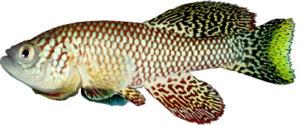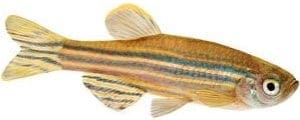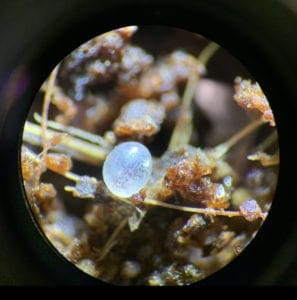Back in its native habitat, the African turquoise killifish wiggles from its egg, eats, spawns and dies — all within a few months. Life goes by fast when your home is a quickly evaporating pond of rainwater. But even when raised as pets in a home aquarium, these killifish still live for less than a year.
For researchers studying aging, that’s a good thing. It turns out that the fish mature much like humans do — but far more rapidly. That makes them helpful for efficiently studying the aging process, and it’s why research labs focusing on the fish are growing exponentially.
Now Bérénice Benayoun, who was on the first team to sequence the fish’s genome, has joined the USC Leonard Davis School of Gerontology from Stanford University. She is bringing Nothobranchius furzeri to USC for the first time, so insights on aging are sure to follow.
Connections to Aging
The fish go through many of the same aging processes that human beings do. As they get older, their injured tail fins regenerate more slowly, just as humans find it harder to heal wounds. They’re also prone to cancer — 30 percent of them die with liver cancer — making them a good model for studying the disease. Male fish even lose their bright colors as they age.
Fussy Fish
It takes special attention to raise Nothobranchius furzeri in the lab:
- They’re fed baby brine shrimp in their early weeks, before moving on to food pellets formulated by researchers.
- Aquarium water must flow slowly to mimic the creature’s near-stagnant native waters.
- Their surrounding room temperature must be 26 degrees Celsius — nearly 79 degrees Fahrenheit.
- Fertilized eggs are removed from the water and placed on moss beds to simulate the dry seasons of Zimbabwe and Mozambique.
Fish vs. Fish
USC’s killifish will share space in a room with other USC researchers’ zebrafish. Here’s how these fish compare:

AFRICAN TURQUOISE KILLIFISH
Its short life makes it ideal for understanding how organisms break down
Lives in Eastern Africa
Lifespan of about six months

ZEBRAFISH
Transparent body of young fish makes it ideal for studying development
Lives in Southeast Asia
Lifespan of about five years

Killifish embryo as seen through a microscope (photo courtesy of the Benayoun lab).
Killifish Claims to Fame
- African turquoise killifish have the shortest lifespan of any vertebrate bred in captivity.
- Embryos go into suspended animation during the dry season, emerging from dry mud at first rain.
- Fish can breed within two weeks of hatching.
- It takes only 40 days for the fish to grow to its full size of 2.5 inches long.
This story originally appeared in Trojan Family Magazine with the title “Go Fish!” Killifish photo courtesy of Itamar Harel.





